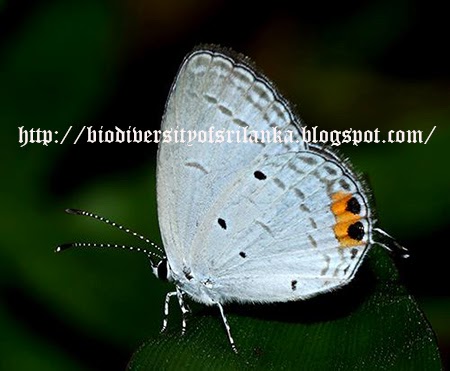Rather uncommon butterfly found in low
country below 1800 ft a.s.l. all the year round while seldom also flies in the hills. Its female occurs in three forms and those
forms vary greatly in width of blue markings though all of them are darker than
the male. One such form mimics poisonous Blue tiger and one of another form mimics
Euploea species (Crows) -also poisonous- and by that escape from its predators. Its food plant are Capparis brevispina and Capparis zeylanica (සුදු වෙළන්ගිරිය) of the family Capparaceae.
Pages
- Home
- Flora of Sri Lanka
- Dragonflies & Damselflies of Sri Lanka
- Butterflies of Sri Lanka
- Freshwater Fishes of of Sri Lanka
- Amphibians of Sri Lanka
- Snakes of Sri Lanka
- Tetrapod Reptiles of Sri Lanka
- Mammals of Sri Lanka
- Resident Birds of Sri Lanka
- Migrant Birds of Sri Lanka
- Vagrant Birds of Sri Lanka
- Status Uncertain or Doubtful Birds of Sri Lanka
Tuesday, October 30, 2012
Monday, October 29, 2012
කොටිකන් වවුලා[Kotikan Waula]/Great horse-shoe Bat/Lesser Woolly Horseshoe Bat (Rhinolophus beddomei sobrinus)
Great horse-shoe bat is restricted to
forested areas of both wet and dry zone lowlands. However a specimen from
Madamahanwara (1077m a.s.l ) was also collected ( Bats of the Indian Subcontinent – P.j.j. Bates and
D.L. Harrison, 1997). It spends the day time hanging by one foot, with
their wings wrapped around them in a hollow tree or a small cave. Great
horse-shoe Bat lives solitary, in pairs or as small parties of up to three individuals.
It emerges in the late evening from its diurnal roost and flies low over the
ground among low bushes and along jungle paths in seeking of its prey which
consists of beetles, termites and other flying insects. Race sobrinus is
endemic to Sri Lanka
Saturday, October 27, 2012
Brown Awl (Badamia exelamationis)
Rather rare skipper found in all elevations
of the country in all the year round while scarce in higher hills. It is a
migratory species and sometimes appears in great numbers usually in company
with Ceylon Banded Awl (Hasora badra lanka) and White-banded Awl (Hasora
taminatus taminatus). It is less afraid of sun unlike other two and often visits
flowers even on a bright day. The larva feeds on Terminalia bellirica and Hiptage benghalensis.
Thursday, October 25, 2012
බෝ[Bo]/Peepal/Sacred Bo (Ficus religiosa)

An introduced tree from Himalayan forests of
India Sri Lanka Sri Lanka garden of Anuradhapura Sri Lanka Sri Lanka
Tuesday, October 23, 2012
නීලකොබෙයියා[Neela-Kobeiyya]/Emerald Dove/Bronze-winged Pigeon (Chalcophaps indica robinsoni)
Common breeding resident of forests and
well wooded home gardens and plantations of all climatic zones while rare in
higher hills and less common in drier areas. It feeds on various seeds, grains
and berries and spends mainly on ground solitary or in pairs. Emerald Dove
breeds all the year round but peak in February to March and possibly again in
September. The nest is placed in a small tree or bush in jungle usually not
very high from the ground where it lays two eggs.
Friday, October 19, 2012
Black-tailed Godwit (Limosa limosa)
Common winter migrant to the coastal areas of the dry zone and also
to the some inland water bodies. During
its stay here Black-tailed Godwit inhabits marshes, coastal mudflats, lagoons,
paddy fields and tanks singly or as small to large flocks. Black-tailed Godwit was formerly considered
as a rare vagrant but in 1944 W.W.A Phillips recorded 200 to 300 birds at
Mullativu lagoon (Phillips W.W.A 1978) and since then it has become a common
winter visitor to the island. It breeds in Europe and Western Asia .
සිංහලෙන් කියවන්න >>
Wednesday, October 17, 2012
Monday, October 15, 2012
Saturday, October 13, 2012
Bush Hopper (Ampittia dioscorides singa)
Common insect found in lowland paddy fields
and grasslands up to about 500 m a.s.l. Its larva feeds on paddy (Oryza sativa), Leersia hexandra (ලෙව්/Bareet Grass) and also on Carpet grass/පොටු තණකොළ (Axonopus compressus) when offered.
Thursday, October 11, 2012
Tuesday, October 9, 2012
Common Redshank (Tringa totanus)
Common Redshank is a common winter migrant
mainly to the dry coastal areas. It is less common in wet zone and occasionally
occurred in inland. It feeds on crabs, mollusks, worms and other aquatic
animals in shallow water in mudflats, salt marshes, coasts, lagoons, etc
solitary or as small groups, sometime with other waders. Race eurhinus (Status of the other race terrignotae in Sri Lanka is considered as uncertain) which is the most common in Sri Lanka Central Asia .
සිංහලෙන් කියවන්න >>
Sunday, October 7, 2012
Friday, October 5, 2012
Indian Cupid (Everes lacturnus parrhasius)
Rather uncommon butterfly occurs all over
the island in all the year round from sea level to about 1500m a.s.l. Larva
feeds on Grona heterophylla (මහ උඳුපියලි/Spanish clover), Grona heterocarpos (ඇත් උඳුපියලිය/Asian ticktrefil), Desmodium triflorum (හීන් උඳුපියලිය/Creeping tick threefoil/Tick clover), Desmodium uncinatum (Silverleaf Desmodium) and Desmodium pryonii of the family Fabaceae.
Wednesday, October 3, 2012
Brown Shrike (lanius cristatus)
Brown shrike is a migrant to the island. It
occurs as two races in Sri Lanka Sri Lanka
සිංහලෙන් කියවන්න >>
Monday, October 1, 2012
වද/සපත්තු මල්[Wada/Sapaththu Mal]/Shoe-Flower/Chinese Hibiscus (Hibiscus rosa-sinensis)
Large shrub with flowers with varies colors
such as red, white, orange, pink, purple, yellow and sometimes brownish-yellow
with a red center etc. It is native plant of China
Subscribe to:
Comments (Atom)














